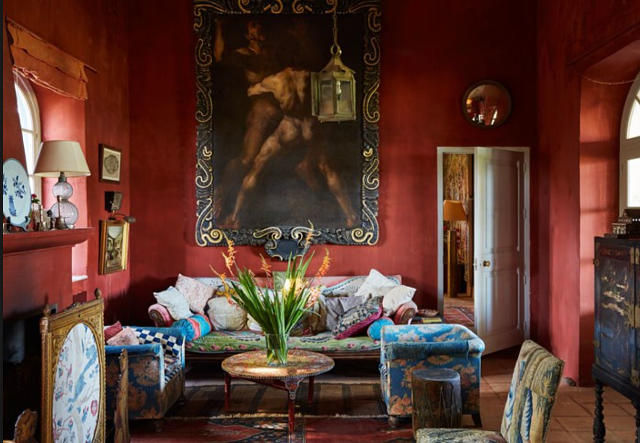There are three distinct 21st Century nouveau riche approaches to interior design…three vomit-bag aesthetics favored by socially insecure people with too much money and no taste to speak of. A generally over-sized feeling, gold everything, too many drapes, questionable paintings, gaudy chandeliers, imitation ancient-Rome statues, huge windows, 14 foot tall ceilings, etc.
The offense-givers are (a) Kardashian Splendor (i.e., way too much conspicuous luxury, every nook and cranny designed and furnished like a luxury hotel, the exact opposite of distressed bohemian), (b) Uday and Qusay Hussein Palatial — Middle Eastern gold-and-marble kitsch, more conspicuous luxury, too many mounted 4K flat screens, large fountains and jacuzzis, and (c) Aggressive Putin, or the home stylings of an ostentatious Russian gangster — the main idea is to announce to the first-time visitor, “Look how much man money I have!…trust me, what I’ve spent on this place is only a fraction of my total holdings.”
“Distressed Bohemian,” posted on 8.5.18:
For decades my default definition of “taste” was one attributed to Francois Truffaut — “Taste is a result of a thousand distastes.” Which feels right as rain and a comfortable concept in this corner. If Hollywood Elsewhere is about anything, it’s about distastes. (And therefore about loving and worshipping things that don’t inspire pique or revulsion all the more.)
This morning I decided to add a supplement. It comes (or came rather) from London designer Christopher Gibbs, a renowned interior designer, antiques dealer and fashion maven who died two or three days ago at age 80. Taste, Gibbs said, “is something you catch, like measles or religion.”
18 years ago Christopher Mason explained that Gibbs “is a leading proponent of that elusive brand of anti-decoration, high-bohemian taste favored by self-confident Englishmen, a look based on well-worn grandeur, disarming charm and unexpected contrasts. The magic is in the mix of masterpieces and oddities — like an assemblage of refined and wild-card house guests who mysteriously combine to create the ideal convivial country-house weekend. The allergy here is to the banal, not to dust.”

This aesthetic, which I’ve sworn by (or tried to swear by) for decades, is all but dead in this country, certainly among the flamboyantly wealthy. It’s been killed for the most part by the wannabe-Kardashian mentality that says everything has to look obnoxiously expensive and McMansiony, which is to say grand and over-sized and generally lacking in aroma and historic texure, which is to say clueless for the most part.
Gibbs: “I like things in their natural state — people especially. As life goes by, that’s what I admire: objects and people that are unmonkeyed with, that are themselves, not trying to be something else.”
The Times obit, written by Sam Roberts, reminds that Gibbs’ Cheyne Walk home in London “was borrowed by Michelangelo Antonioni for the party scene in his movie Blow-up (1966) and by Kenneth Anger to shoot the occult film Lucifer Rising (’72). Gibbs also designed what he called the “earthly paradise” inhabited by the has-been rock star played by Mick Jagger in Donald Cammell and Nicolas Roeg’s film Performance (’70). A similar aesthetic was used for the spacious vampire home occupied by Tilda Swinton and Tom Hiddleston in Jim Jarmusch‘s Only Lovers Left Alive.









